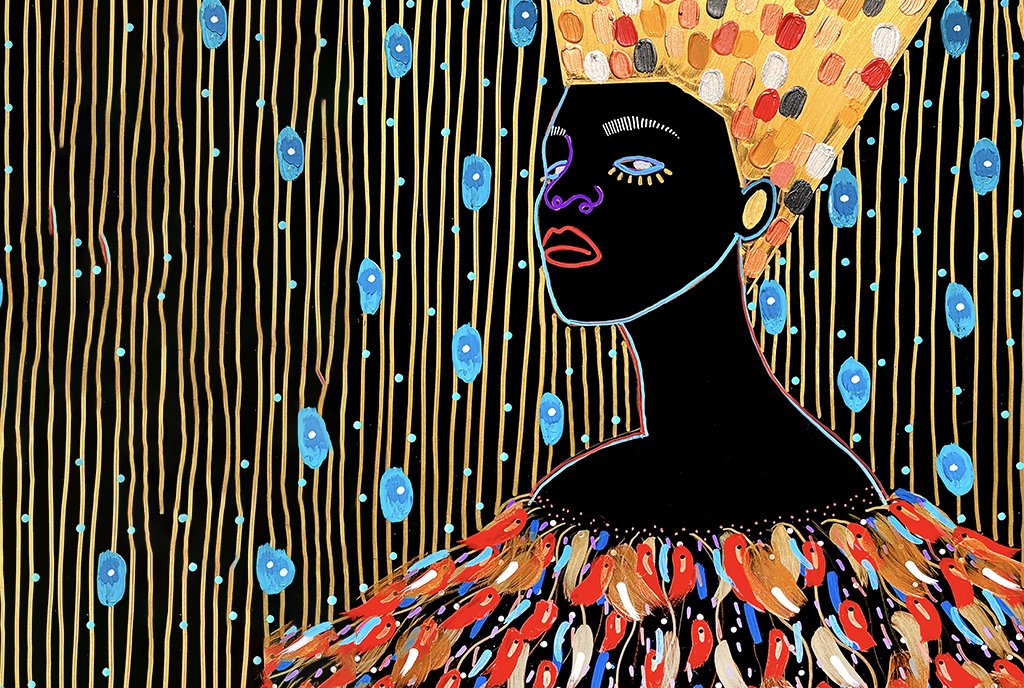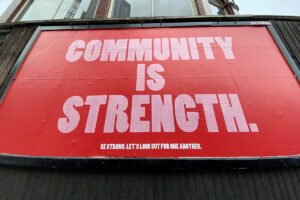
Editors’ note: This piece is from Nonprofit Quarterly Magazine’s spring 2024 issue, “‘Stop Drowning Us, and Stop Making Us Disappear’: A Critical Report on the State of Black Woman Leadership.”
“I am sick and tired of being sick and tired.”1 Civil rights activist Fannie Lou Hamer said those words in 1964, and they are just as true for Black women today as they were then. The context has changed, but the situation remains the same.
This is especially true for the women, like me, who are relentlessly pushing for all people to be wealthy and well while too often sacrificing their own wellbeing. We operate in a system that does not want us to succeed. Our economic system was repeatedly designed to keep Black people out. Any time progress has been made, it has been limited, because those working to improve the system have not wanted Black people to benefit.
When the labor movement started to organize, the establishment asked, How can we keep the Negroes out? When Social Security helped reduce poverty, the establishment asked, How can we keep the Negroes out? When the country began to invest in the middle class through the GI Bill, the establishment asked, How can we keep the Negroes out? When Black people started to move North for safety, they asked, How can we keep the Negroes out? When women got the right to vote, they asked, How can we keep the Negro women out?
I am a “Negro woman” and the cofounder and CEO of Blk Grvty, an organization designed to make it normal for women, Black people, and Indigenous people worldwide to be wealthy and well. Blk Grvty develops pilots for financial models, products, and services that can be adopted by the economic marketplace at scale. We advise public, private, and philanthropic leaders to influence how, when, and to whom capital flows, aiming to change institutions and systems so that they are inclusive by default. When we achieve systemic inclusion, there will be a paradigm shift for humanity. People will be healthy. Families will thrive. Communities will be strong. The economy will be resilient. The planet will be fertile. And instead of being “sick and tired,” I—along with countless other Black women—will be well and rested.
The Power of Capital
For more than 20 years, I have worked with government, philanthropy, and community-based institutions to get better outcomes for people in education, health, housing, workforce development, small business, and more. Using frameworks like Results-Based Accountability2 and Collective Impact,3 but with an antiracist and community-centered analysis, I have helped hundreds of communities map out their vision, strategic partnerships, and data-driven plans—all in an effort to acquire the tools and resources necessary to achieve their desired results. While I observed some progress, it was often incremental change rather than change at scale.
When we achieve systemic inclusion, there will be a paradigm shift for humanity. People will be healthy. Families will thrive. Communities will be strong. The economy will be resilient. The planet will be fertile. And instead of being “sick and tired,” I—along with countless other Black women—will be well and rested.
I conducted a root-cause analysis of my work, asking why? as many times as possible to figure out what was leading to limited change. In this analysis, one thing became abundantly clear: there was a lack of significant capital being invested into the communities in which I was working to change conditions for people and see better outcomes across systems.
In my own journey, I’ve come to appreciate the power of capital in ways I hadn’t early on in my life and work. Being acutely aware of how Black minds and bodies were used as assets to generate trillions in wealth for others with little to show for it in terms of our own wealth, I saw capitalism as purely extractive and leaving countless bodies in its wake. While this remains true, I have had to reckon with how participating in the capital market can close gaps and generate new wealth.
This approach became even more real when I worked with an investor who had a growth mindset. I witnessed $50 million become $350 million and $350 million become $1 billion.
Working with venture capitalists, private equity investors, and impact investment funds, I’ve watched how an infusion of capital and effective operational support can stabilize, strengthen, and grow a business, ultimately producing resources that benefit everyone involved—including, by extension, their families and communities. These events are life-changing, as they create economic security and a path to wealth and wellbeing.
So I ask: Why not take the same approach to close the racial wealth gap? Imagine an infusion of capital for Black people simply to provide the tools and resources necessary for us to participate as real competitors in the capital marketplace. Everyone would benefit, because the system would be designed to include us. With free rein and our full participation, witness the power of Black people unleashed in freedom. Everyone could enjoy the benefits of our creativity and genius…but this time, we would reap the rewards.
Yet this idea, my friend, is terrifying for too many…and this is why I remain exhausted. I will persist, however, because I see a world in which we have wealth and wellbeing for everyone to enjoy. I see a world where we are not focused on GDP but rather on a regenerative economy—one in which everyone has enough to be well, evidenced by the health of people, wildlife, and our planet.
Capital Battles
I agree with Sarwat Jahan and Ahmed Saber Mahmud’s assessment that we must “take appropriate steps to protect the free market from powerful private interests that seek to impede its efficient functioning. The concentration of ownership of productive assets must be limited to ensure competition.”4 Essentially, “save capitalism from the capitalists.”5 When we create loopholes to exclude, it taints the system, allowing for exploitation and corruption—which is what we continue to experience in our economy.
I feel pulled apart each day, trying to push a door open for the amazing Black people who deserve it while also having to continuously defend myself for even trying to bring wealth and wellbeing to everyone.
The point is, not only are resources available, but principles for investing for scale are also on the ready and being used as core operating practices in business. If we apply these principles to our social systems, I guarantee we will see more than incremental change. Unfortunately, we are conditioned to support programs in the social sector. That means the level of investment necessary for change at scale remains out of reach.6 I wonder if people even believe it’s possible to live in a world in which people are healthy, productive, conscientious of our impact on the planet, and economically secure instead of mindlessly participating, mimicking behaviors that purport to get the job done?7 I believe it is possible.
As I’ve come to understand how to leverage capital for better outcomes, I’ve found myself tiptoeing in some spaces for fear of reprisal from those who rail against capitalism. Let’s be clear: money alone does not solve everything; but it is the currency we have for existing in our current economy—and without proper financial investment, in the long run, our work will be in vain. It is why Ms. Hamer’s words resonate so strongly 60 years later. I am for economic justice, but it requires more than the 5 percent tranche that philanthropy is legally obligated to pay out annually to address the large-scale social problems driven by business decisions.8 (And note that the amount hasn’t changed since the tranche was first established, in 1969. Fifty-five years later, our problems have become more expensive.9) These dollars are important, but they should be used as leverage to attract larger dollars and government support to take systems change strategies to scale.
So the battle continues, on all sides. Not just what you would expect—resistance from those who want to amass and concentrate wealth among an elite few—but also from my colleagues who have committed to fight for racial and economic justice alongside me. They, too, get stuck drawing hard lines and operating in binaries (pro or anti, right or wrong, black or white), when a more open approach (both/and, multiple truths, and gray) might be a better choice for advancing their agenda. I feel pulled apart each day, trying to push a door open for the amazing Black people who deserve it while also having to continuously defend myself for even trying to bring wealth and wellbeing to everyone.
There are three fronts on which I find myself constantly battling: (1) extractive capitalists, (2) poverty brokers, and (3) not-so-impactful impact investors.
Sign up for our free newsletters
Subscribe to NPQ's newsletters to have our top stories delivered directly to your inbox.
By signing up, you agree to our privacy policy and terms of use, and to receive messages from NPQ and our partners.
The extractive capitalists
On more occasions than I can count, I’ve sat across from someone who says with pride and a hint of defensiveness: “I’m a capitalist.” Without acknowledging how the system is exploited to benefit some and disadvantage others, it is challenging for me to engage in a real conversation about capitalism. A core principle of capitalism is achieving the most profit possible by making the “best” use of an available resource or product. The problem is in how the “best use” is defined, as greedy humans focus on making the most profit possible rather than the highest profit possible.
For example, the highest use of Earth is to allow it to produce clean air, clean water, and the minerals necessary for healthy life—but by focusing on the most profit, we are destroying our environment, extracting from it, and creating hazardous environments and uninhabitable living conditions. Someone is certainly making a profit—but the rest of us are suffering.
This is bad behavior, full stop. It is an extraction of resources and an exploitation of a system, and it is counter to facilitating the best and highest use of a rich resource. What’s worse is that we all know and feel it, but we allow ourselves to remain complicit in perpetuating such exploitation. Why not use Earth’s resources to cultivate a healthy, fruitful, vibrant environment in which all beings can thrive? That world is absolutely possible!
We can reset how capitalism is operationalized. A great place to start is in the asset-management industry, where there are $82.24 trillion in assets under management (AUM) available.10 Right now, almost 99 percent of asset managers are White men,11 and because people invest in those who look like them, that means most capital is flowing away from communities of color and back into White—and wealthy—communities.12 We need more Black and other New Majority people to be investors, with power to direct how money flows, ultimately influencing business growth, job creation, community investment, and government policy. So many studies demonstrate that diverse teams get strong returns, and it only makes sense to have a more representative group of managers making non-extractive investment decisions for an increasingly diverse populace. Still, I witness fund managers getting fewer dollars to invest in/with Black and Latinx women, who are suffering the most.13 (The data I used in my research did not account for Indigenous women—a substantive gap.)
The poverty brokers
These are the people who fight for racial economic justice while collecting their checks from nonprofits, philanthropy, and government—institutions underwritten by historically extractive capitalism. They rail against capitalism without a real analysis of what it is and what it can be. They’re also comfortable focusing on solving for poverty, which is insufficient if we want to bring wealth and wellbeing to everyone. Even if we bring everyone above the federal poverty limit, we will still have a vastly unequal and inequitable society.
While many poverty brokers work in nonprofit, philanthropy, and activist spaces and agree with the need to close the racial wealth gap (as the average White family has about seven times the wealth of the average Black family14), they are not willing to do what it takes to actually achieve this. Building wealth requires a different mindset and approach than solving for poverty. Although both strategies are necessary, they are not the same.
I have worked to design strategies to support fund managers of color, only to be asked why I am trying to help rich people over poor people. If we are not helping out the most vulnerable, they think, there’s no point in helping at all. They do not see that intervening in the mechanisms of capitalism will eventually help everyone—that supporting fund managers of color is not about the people but, rather, the system.
I do sympathize with the poverty brokers in the sense that whatever solutions are designed need to incorporate strategies that keep people from being poor. I do wish our system was different. But it is not, and it will not change anytime soon. Designing different programs to service different needs will not get us to the place where we can close racial wealth gaps or reduce income inequality. If we want to truly change things, we must harness our economic engine to produce different results.
I have seen similar dynamics with impact investors. They want to help Black people; they do not want to invest in Black people as a valued asset.
The not-so-impactful impact investors
Impact-first funders should be a natural ally—and most of the time, they are; but many of them operate with a programmatic mindset similar to the poverty brokers. Even worse, like the extractive capitalists, they cannot imagine a world where Black people are wealthy. Many, if not most, operate with a deficit mindset that sees problems to be solved rather than solutions in which to be invested.
Research from Illumen Capital and Stanford University looked at real-life investment decision-making and found something surprising: after asset allocators reviewed high-performing teams led by Black men, they reported lower status scores on a social status test.15 Basically, the allocators felt threatened by the competency of these Black people.
In contrast, when reviewing low-performing teams led by Black men, the allocators preferred those teams over teams led by White men with similar performance.16 They were rooting for those Black people, even if they did not want to invest in them. In other words, they were more comfortable with low-performing Black people because that reinforced their assumptions about themselves as the superior and more deserving group.
I have seen similar dynamics with impact investors. They want to help Black people; they do not want to invest in Black people as a valued asset. This keeps the status quo in place, with Black people on the bottom, seemingly needing a handout, rather than dismantling the mechanisms that keep us down to begin with.
True Wealth
All hope is not lost, however, as extremely wealthy people are making bold moves. MacKenzie Scott and Melinda Gates, for example, are directionally right. Keep doing it. Keep giving money away. We have to take a growth equity approach. Provide the capital to cover the gap from generations of loss and extraction. Provide the operational support to ensure the participants have the tools to be successful, and release the need to be arbiters of the game. Wealthy and well are an array—they manifest differently for different people. And this array shouldn’t be prevented by elitist, extractive capitalism.
Many people, especially those without the expertise and understanding of capital flows, hear my arguments and think that I am whitewashing the issues or repackaging the age-old advice of “Pull yourself up by your bootstraps.” Many question my motivations and think that I am just trying to make myself and my friends rich. I do want to be wealthy and well. I want to live in a world where we are not driven by fear and scarcity but rather hope, abundance, and deep reverence for a rich Earth that allows us to evolve, grow, innovate, create, invest—and repeat. We will not all become millionaires, but we can all have wellness and security—which is why I fight on these three battlefronts each and every day.
I am determined to be a good ancestor. As my ancestors fought through their own “sick and tired,” I will continue to push through mine, working for change and trusting the next generation to pick up the torch and carry on until we reach the mountaintop, where we can all be wealthy and well.
Notes
- See Lottie L. Joiner, “Remembering Civil Rights Heroine Fannie Lou Hamer: ‘I’m Sick and Tired of Being Sick and Tired,’” Daily Beast, last modified April 14, 2017, www.thedailybeast.com/remembering-civil-rights-heroine-fannie-lou-hamer-im-sick-and-tired-of-being-sick-and-tired; and Jamie Gass, “Fannie Lou Hamer: ‘I Am Sick And Tired Of Being Sick And Tired,’” WGBH, last modified May 7, 2018, www.wgbh.org/news/commentary/2017-10-03/fannie-lou-hamer-i-am-sick-and-tired-of-being-sick-and-tired.
- See Living Cities, “A Beginners Guide to Anti-Racist Results Based Accountability (RBA),” Medium, October 1, 2019, medium.com/@Living_Cities/your-beginners-guide-to-anti-racist-results-based-accountability-rba-a1e3fae60055.
- See Tom Wolff et al., “Collaborating for Equity and Justice: Moving beyond Collective Impact,” Nonprofit Quarterly 23, no. 4 (Winter 2016), 42.
- Sarwat Jahan and Ahmed Saber Mahmud, “What Is Capitalism?,” International Monetary Fund, Finance & Development 52, no. 2 (June 2015).
- Raghuram G. Rajan and Luigi Zingales, Saving Capitalism from the Capitalists (Princeton, NJ: Princeton University Press, 2004).
- There is a mental block for social impact gatekeepers. Investments are small, expectations are misaligned, and a hard line between social impact and market impact is drawn, which limits us from making market moves that will have a sizable impact and produce more than just financial returns. Similarly, market investors can’t imagine how adequately resourcing strategies that are good for people and the planet can possibly provide a lucrative return. Therefore, these strategies only warrant small investments or charitable gifts. These approaches keep us in a paradigm of haves and have-nots, and the chasm is only widening. We are driven primarily by our individual, rather than collective, wellbeing, and it is literally killing us. If we shifted our focus to our collective wellbeing, we would experience a healthier and stronger economy. If we took some (not all) of the principles used to scale a business, but centered the collective/community, rather than an individual investor or small group of investors, as the beneficiary, we would reap multifold returns that benefit the whole of us. We have to shift from independence to interdependence.
- Many of us are complicit in maintaining the system as it is designed—so we create programs or marketing campaigns to push for change but we don’t change our behaviors or beliefs. We are not organizing enough people to reject the rules of the game and create new ones. Much of this is due in part to our being stuck: we have to feed our families, pay our rent, cover health bills—hustle, grind, repeat. When we prioritized individualism, we got ourselves caught in a vicious cycle, stuck running in place and making little to no progress—and we’ve psyched ourselves into believing that what we are doing is right, is hard work the American way (bootstrapping) and that it will all work out if only we work, run, grind a little harder. Gaslighting is a core American principle that we need to reckon with—Thomas Jefferson and friends fighting for and proclaiming freedom while exploiting and enslaving innocent people for free labor, and doing so violently. It is the language of our pledge of allegiance and national anthem juxtaposed against measurable disparities that are dictated by a caste system (see Isabel Wilkerson, Caste: The Origins of Our Discontents). It is the request for mostly nonprofit organizations to demonstrate systems change at scale in 18 months or less with limited infrastructure and few dollars to get the job done.
- Jack Salmon, “The Truth About Private Foundations and the 5% Payout Rule,” Philanthropy Roundtable, November 16, 2023, www.philanthropyroundtable.org/the-truth-about-private-foundations-and-the-5-percent-payout-rule/.
- Ibid.
- Josh Lerner et al., Knight Diversity of Asset Managers Research Series: Industry (Miami, FL: Knight Foundation, and Boston, MA: Bella Private Markets, 2021).
- “Knight Diversity of Asset Managers Research Series,” Knight Foundation, accessed February 12, 2024, knightfoundation.org/topics/diverse-asset-managers/.
- Sarah Lyons-Padilla et al., “Race influences professional investors’ financial judgments,” PNAS 116, no. 35 (August 27, 2019): 17225–230.
- Woman and Minority–Owned Private Equity and Venture Capital Firms: 2022 Market Review (West Hartford, CT: Fairview Capital, 2022).
- “Racial wealth gap,” Urban Institute, accessed February 12, 2024, www.urban.org/tags/racial-wealth-gap.
- Lyons-Padilla et al., “Race influences professional investors’ financial judgments.”
- Ibid.








